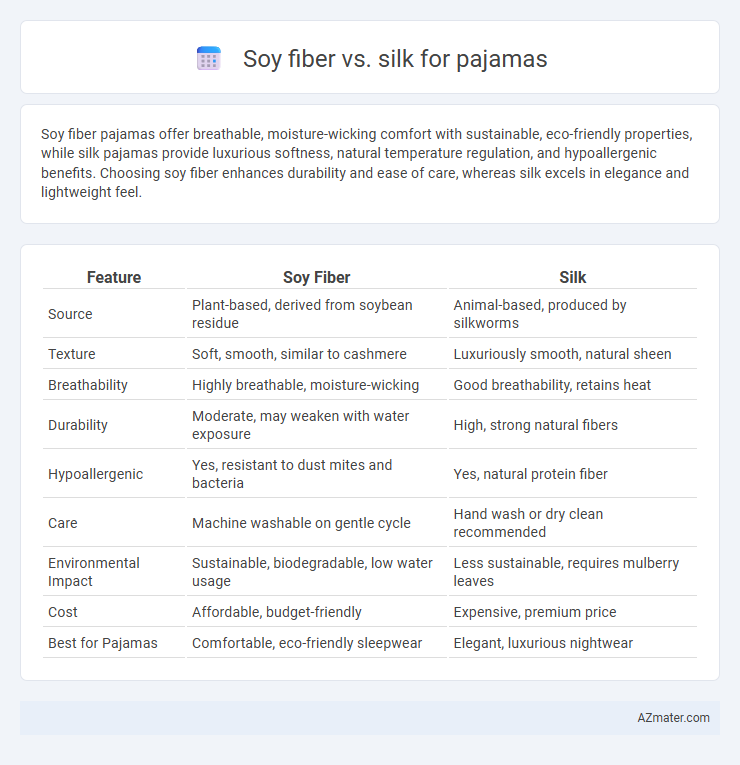Soy fiber pajamas offer breathable, moisture-wicking comfort with sustainable, eco-friendly properties, while silk pajamas provide luxurious softness, natural temperature regulation, and hypoallergenic benefits. Choosing soy fiber enhances durability and ease of care, whereas silk excels in elegance and lightweight feel.
Table of Comparison
| Feature | Soy Fiber | Silk |
|---|---|---|
| Source | Plant-based, derived from soybean residue | Animal-based, produced by silkworms |
| Texture | Soft, smooth, similar to cashmere | Luxuriously smooth, natural sheen |
| Breathability | Highly breathable, moisture-wicking | Good breathability, retains heat |
| Durability | Moderate, may weaken with water exposure | High, strong natural fibers |
| Hypoallergenic | Yes, resistant to dust mites and bacteria | Yes, natural protein fiber |
| Care | Machine washable on gentle cycle | Hand wash or dry clean recommended |
| Environmental Impact | Sustainable, biodegradable, low water usage | Less sustainable, requires mulberry leaves |
| Cost | Affordable, budget-friendly | Expensive, premium price |
| Best for Pajamas | Comfortable, eco-friendly sleepwear | Elegant, luxurious nightwear |
Introduction to Pajama Fabrics: Soy Fiber vs Silk
Soy fiber pajamas offer exceptional breathability and moisture-wicking properties, making them ideal for temperature regulation and comfort during sleep. Silk pajamas provide a luxurious, smooth texture with natural hypoallergenic qualities, promoting skin health and a premium feel. Both fabrics excel in softness and durability, but soy fiber emphasizes eco-friendliness while silk highlights elegance and natural sheen.
What is Soy Fiber? Origins and Properties
Soy fiber, derived from soybean protein, is a sustainable and eco-friendly textile known for its softness and breathability. Originating from the natural byproducts of soybean processing, this fiber offers moisture-wicking properties and a smooth texture similar to silk, making it ideal for comfortable pajamas. Its hypoallergenic and biodegradable nature enhances skin sensitivity benefits while supporting environmentally conscious fashion choices.
Silk: History and Unique Characteristics
Silk, historically known as the "Queen of Fibers," has been cultivated for over 5,000 years, originating in ancient China where it was prized for its luxurious texture and natural sheen. Its unique protein structure, primarily fibroin, provides exceptional smoothness, breathability, and temperature-regulating properties that make silk pajamas ideal for comfort and elegance. Compared to soy fiber, which is derived from plant-based byproducts and offers softness and moisture-wicking, silk's durability and hypoallergenic qualities set it apart for premium sleepwear.
Comfort and Feel: Comparing Soy Fiber and Silk Pajamas
Soy fiber pajamas offer a soft, breathable texture with excellent moisture-wicking properties, providing a cool and comfortable sleep experience. Silk pajamas boast a smooth, luxurious feel that glides effortlessly over the skin, known for natural temperature regulation and hypoallergenic qualities. Both materials enhance comfort, but soy fiber excels in breathability while silk stands out for its silky softness and elegance.
Breathability and Moisture-Wicking Abilities
Soy fiber pajamas offer excellent breathability and moisture-wicking properties, making them ideal for regulating body temperature and keeping skin dry throughout the night. Silk pajamas provide natural breathability with a smooth, lightweight texture but lack the superior moisture absorption found in soy fibers. For those prioritizing moisture management and cooling comfort, soy fiber outperforms silk in maintaining dryness and airflow during sleep.
Durability: Longevity of Soy Fiber vs Silk Pajamas
Soy fiber pajamas typically offer greater durability compared to silk, as soy fibers possess strong tensile strength and resistance to wear and tear. Silk, while luxurious and smooth, is more delicate and prone to damage from abrasion and frequent washing, reducing its lifespan. Continuous care and gentle laundering are essential to maintaining silk pajamas, whereas soy fiber garments endure regular use with less degradation over time.
Eco-Friendliness and Sustainability Factors
Soy fiber, derived from soybean pulp, is a biodegradable and renewable material that requires low water usage and minimal chemical processing, making it an eco-friendly choice for pajamas. Silk, produced through silkworm cultivation, demands significant land, water, and energy inputs, and its traditional harvesting practices raise ethical concerns, impacting sustainability. Choosing soy fiber pajamas supports reduced environmental footprint and promotes sustainable textile production compared to conventional silk.
Hypoallergenic & Skin Benefits of Each Fabric
Soy fiber pajamas offer excellent hypoallergenic properties, making them ideal for sensitive skin by reducing irritation and preventing allergic reactions. Silk fabric naturally repels dust mites and allergens, providing a smooth, breathable surface that promotes skin hydration and reduces friction, which helps prevent wrinkles. Both fibers support skin health, but soy fiber excels in moisture-wicking and antimicrobial benefits, while silk enhances softness and temperature regulation for optimal comfort.
Care Instructions: Maintenance for Soy Fiber and Silk Pajamas
Soy fiber pajamas require gentle machine washing in cold water with mild detergent to preserve their softness and prevent fabric damage. Silk pajamas demand even more delicate care, typically hand washing in cold water or using a specialized silk detergent to maintain their sheen and prevent fiber weakening. Avoiding high heat drying and using low-temperature ironing enhances the longevity of both soy fiber and silk pajamas, ensuring optimal fabric quality over time.
Price Comparison and Value for Money
Soy fiber pajamas typically cost less than silk, making them an attractive option for budget-conscious shoppers seeking soft, breathable sleepwear. While silk pajamas offer a luxurious feel and natural temperature regulation, their higher price point may not provide proportional value for everyday use. Considering durability and maintenance, soy fiber delivers better value for money by combining comfort and affordability without the delicate care requirements of silk.

Infographic: Soy fiber vs Silk for Pajama
 azmater.com
azmater.com